The Defense Training Program
A dramatic feature that today might not be possible was the publication of a serial story, with illustrations, called "Attack on America, A Serial Every American Should Read." In this series, a buildup of foreign hostiles is discovered in Mexico, and subsequently mounts air attacks on Texas and even Washington, killing the President.
Less dramatic but in the same vein was the local version of the "Defence Training Program," a federally sponsored mechanics course designed to prepare young men for mechanical skills applicable to modern farming and automotive careers but with an obvious military motive as well. For those who like "lists," and one like this is fascinating, here are the boys enrolled in Stromsburg's Defence Training Program:
Richard Anderson, Donald Burg, Max Doggett, Lloyd Erickson, Willard Hollister, Howard Hurd, John Knerr, Kermit Lindgren, Robert Oberg, Dennis Rystrom, Durward Rystrom, Mervin Rystrom, Quintin Torell and Harlan Younglund.
Their instructor was Alex Swanson, who appears on page 299 of the 1972 history book with his brother Nels and the miniature auto they constructed around 1907. The trainees could not have asked for a more skilled mentor than Swanson. Do you have any relatives in the list above? Or, like me, do you see familiar acquaintances?
-Dalakarl
.........................
The Stromsburg Men's Chorus
Yet another example of a vanishing feature of community life which the written records remind us of is the male chorus which was thriving in the immediate pre-world war two era. This remarkable assembly gathered for weekly rehersal at the high school under the direction of E.C. Swanson with Walter French at the piano. They performed at home and in surrounding communities to appreciative audiences.
This phenomena was characteristic of Scandianvians but could be found in other ethnic communities as well. Our grandsons' great grandfather on the Brugman side was active in a barber shop chorus in southeast Nebraska in very recent times. Perhaps you will enjoy seeing the list of those who participated in the local chorus; names familiar to many of us.
Alfred Anderson, Herbert Anderson, Glen Sack, Albertus Larson, A. Noreen, Cecil Bennett, Wallace Fredrickson, Alex Swanson, Evan Myers, Loris Neal, Orville Hennings, Edwin L. Anderson, Melbourne Olson, Calmer Youngquist, Don Frisbie, Stanton Moore, Richard Nelson Jr., Rolland Johnson;
Quentin Torell, Willard Hollister, Harris Sundberg, Fred Bond, Morace Baker, Art Cedarberg, F.A. Swanson, R.E. Nelson, Curtis Samuelson, Gordon Fredrickson, Wayne Anderson, Lloyd Erickson, John Seymour and Kenneth Myers.
Would that we could hear them again!
-Dalakarl
....................
The Edgren Memorial
This 1939 announcement marked the 100th year since Edgren's birth and gives us an occasion to think once more of the Central Bible Seminary, as we do each year on the Midsommar Festival bus tour of the "sights and sites" of Stromsburg. Yes, it is hard to imagine that corner of Ekeley and Fourth streets as the location of the seminary building, out on "the edge of town."
The story goes on: "Among the first students to enroll were Albert and John L. Hedbloom, who, with 22 others constituted the first class... the forty acres on which it was located was donated by John Ekeley and later became the Bryant Normal University which burned April 21, 1898. Dr. Edgren, on account of failing health had gone to California in 1887...
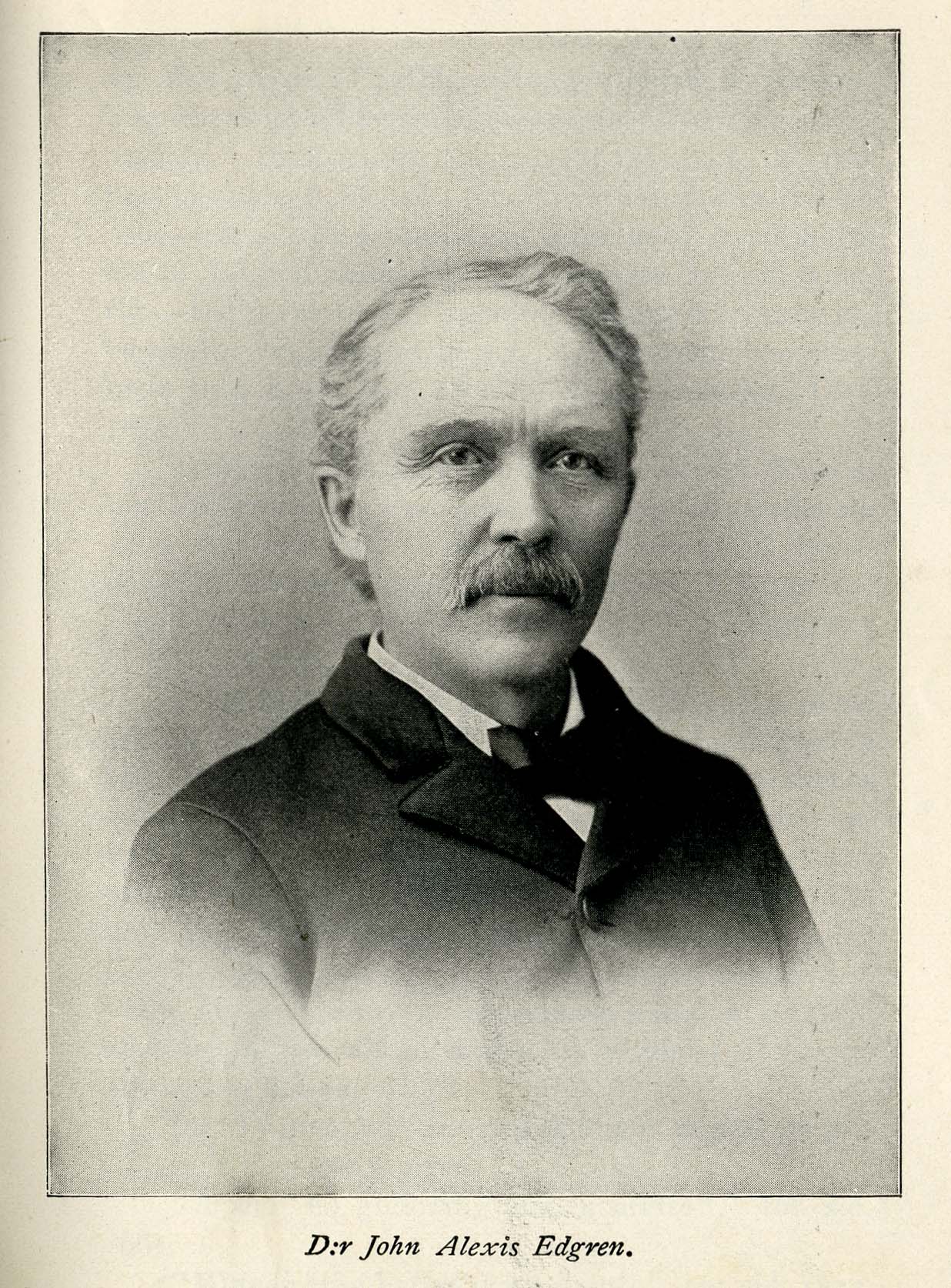
Edgren as pictured in A.G. Hall's history, 1899
Dr. Edgren was an outstanding preacher and instructor in the Swedish Baptist cause in America, so much so that the church, on this, his one hundredth anniversary, pays honor to his memory all over the land."
So Seminary street and Ekeley street are reminders of these people. (But what about Home street which does not line up with "the home" on 9th, or Park street which leads to no park I am aware of?)
The great Chicago fire destroyed the First Swedish Baptist church where, in the basement, Edgren had started the first seminary. A few years ago I stood on that site in Chicago's old "Swede Town," now very different but still home to the successors of the Swedish Methodist and Swedish Covenant churches on their original sites. The Edgren seminary was later in Morgan Park in the south part of Chicago and finally wound up in the twin cities: Bethel Seminary.
-Dalakarl
.....................
Chattie in "Who's Who"
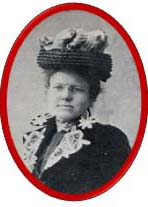
The Community Club is lavish in its praise of their hometown editor. "The Stromsburg community and the many personal friends of Mrs. Chattie Westinius may well be proud of the signal honor accorded her as a result of her selection." In concluding, "She is an outstanding example of what character, industry and ability combined with a conscientious desire to assist her fellowmen may accomplish in a community."
Let's add to that, were it not for her paper we would not have the wealth of material to fill this column. She remains a beacon for gender equality by example, and many "green" Swedes must have polished their English by reading her local news and ads in the early years.
-Dalakarl
...................
Panorama of the Square
Little did we expect to find out more things about the early panoramic photograph of the Stromsburg square, when in the May 8, 1941, issue of the paper, editor Chattie unearthed some more facts. Folkets Vän 168 had this to say about that picture:
"... the panoramic photo of the square (was) done by photograper F.E. Taylor of Broken Bow, Nebraska. He does not date the picture, but the new Victor Anderson building is not yet there so it must predate 1918. First National building is there, so it is after 1901... Another version of this panorama has survived in tinted form and in that photo the darker parts are made lighter so the buggies around the square show up better.
Since that picture dates from the time grandpa John Greenwall was in Stromsburg, it gives me shivvers to think he might be one of the many figures seen up and down the streets around the square. Judy Anderson tells me that the negative for this panorama is in the Covenant Home offices and can be made into a two or three foot print for framing. It could also be supplied in digital form, as can the tinted version, from the writer."

Now for the 1941 update. Chattie reports that local resident Mrs. J.G. Green had given the newspaper this panoramic picture which her grandson had purchased from a barbershop in Seward. Since this was Chattie's first encounter of this picture, she was unaware of locals who might have owned a copy which surely must have been the case. For instance, the tinted version which appeared recently in the "photos" section of the Facebook group, "destination Stromsburg," must have been unknown to her.
What she did know was the identity of some of the many people captured in this picture, and here they are: Park Smith, Myron Barber, Nels Stafford, and depot agent Robert Beer. Sadly, grandpa is not mentioned but Chattie would have recognized him. She once jokingly referred to him as "the mayor of Durant."
-Dalakarl
..........................
Farmland Ownership in 1941
First, how about the ratio of owners and renters. In the survey, only 28.9% of Polk county farms were operated by their owners; that made 550 out of 1,904 farms in total. What we do not know is how many farms exist now by comparison, but the guess would be many fewer. It would also be interesting to know the current owner/renter ratio.
As an aside, I once asked a bank official in Iowa what he estimated the average size of farms in Pott. county was in terms of total assets. He either did not know or was reluctant to tell me. My purpose in asking was to gather facts to demonstrate that the local retirement home there had in fact a smaller balance sheet than most farms, contrary to the popular local perception. The same might apply here.
In 1941, 23.5% of farms in Polk county were owned by women. Local historian Rich Pehrson has discovered a number of women homesteaders, who were eligible for homesteads only if not the wife of another applicant. In one case, the fact of a marriage was apparently concealed from officials.
By 1941 the female ownership may reflect a kind of "life insurance" measure to secure the family in the event of the husband's death. There were also common instances of a father securing land for his children, both male and female. The highest incidence of women owners was in Stromsburg precinct: 29.3%
Also by 1941 the first generation of owners was fading from the scene, a fact borne out by the 119 farms that were owned "by estates." The ravages of the depression and drought are reflected in the ownership of 85 farms by the Federal Land Bank, the Federal Farm Mortgage Co. and various insurance companies. 216 farms were owned by people outside the county; 133 more by out-of-state interests.
-Dalakarl
...........................
Checking Grandparents' Grave
Recently I received a request to check on the status of a Florida ninety-year-old's grandparents grave. She was not sure whether they were buried in Stromsburg or Swedeburg since it was only in childhood she had seen the spot last. What came next was gratifying, to say the least. Here is my letter to her:
"I don't know if we have met, but I have visited Covenant Village there years ago when I served as administrator of Midwest Covenant Home in Stromsburg. It is so great to hear from someone there now, and I think what I have found will be very interesting to you.
First there are these two pictures of the Swedeburg Lutheran church cemetery where your grandparents are buried and their stone. You will be pleased to see that it is indeed well kept and that the church is still in existence. The cemetery is now called Rock Creek and the church is called Grace Lutheran which is not the way we remember it. Also the Americanized spelling "Nelson" has replaced "Nilsson" as often happens.
I was able to find these pictures on the Find-a-Grave internet website, posted by a Lee Martinson. The Martinsons were among the charter members of the Swedeburg Covenant church which was just down the road from the Lutheran church. Many families had members in both churches.
But I can share much more about the Swedeburg-Mead-Malmo-Wahoo Swedish communities if you will look online at www.dalakarl.com, go to the immigrant church section and on to Saunders county. There are pictures of the Swedish churches in each location, pioneer pastors and stories. The school you mention is no doubt Luther Academy/College which was at Wahoo for many years. I know alumni from there as well as many folks from the Swedeburg area. There are many wonderful stories about this region, even my own grandmother was born just south of there near Ceresco, but traveled north to Wausa (my home) in a horse drawn wagon.
Thank you for your email and I hope we can stay in touch about our common interest in the immigrants...for instance, I would like to know which churches you served in since surely we have some acquaintances in common..."
As a result, we had a delightful phone conversation, and in the mail a few days later I received a copy of her book detailing her family tree. How neat was that?
-Dalakarl
..........................
Another New Sweden Iowa - Stromsburg Connection
Recently several books have surfaced which would be of interest to Folkets Vän readers. One of them, "Peter Cassel and His Family," is the story of immigrants to Iowa in the New Sweden and Madrid (Swede Point) areas very early in the process that brought our ancestors to America.
Because of my earlier reading of the articles about Peter Cassel and New Sweden, IA, it caught my eye that we had people in Stromsburg with a variant spelling, Castile, mentioned in the old newspapers. It was also noticed that the origin of one of these, John Castile, hailed from Jefferson county where New Sweden was located. Along with my letter ordering the book, I asked the family about possible connections.
I might backtrack a bit to mention that the largest group to migrate from New Sweden to Stromsburg were the Baptists; including "Sailor" Peterson, Peter Carlson (both preachers), Blooms and some Schillerstroms. The Dalakarl website displays a picture of an anniversary gathering of Swedish Baptists at the Brush Creek baptismal site and possibly the bronze marker plaque which stands at their cemetery to the east of the Lutheran church. We visited there in around 2011.
Some comments on the John Castile obituary found in the Headlight:
The hospital in Hastings where he died may have been the state mental hospital; was he the victim of Alzheimers disease? His home farm northwest of York would be just to the south of Polk county and Stromsburg, where he, his wife, and an infant, Edward, are buried. The dates are; John 1854-1936, Matilda 1858-1941, Edward James 1888-1889.
A well-known later merchant in Stromsburg was Robert L. Castile whose Wilson-Castile Daylight Store was also a general merchandise business. Might there be some connection? Could this have been the Robert Lincoln Castile listed on Find-a-Grave, born in Iowa in 1864 and died 1959 in Livingston, California, wife Emma Wall Castile?
There is no Robert L. buried in Stromsburg, but there is a Robert G. Castile buried in York, NE, who turned out to be an infant son of Andrew Albert Castile (1850-1932) and Emma Castile (1854-1935). Might this Andrew be a candidate for one of the unidentified "two brothers" mentioned in John's obituary?
The author responded that the variant spelling was indeed connected with his ancestors, and that the John Castile buried in Stromsburg might be the son of the New Sweden Castile. It was also possible that others here are connected, but the Daylight Store Castile remains unconfirmed. (Stay tuned, there is more to follow)
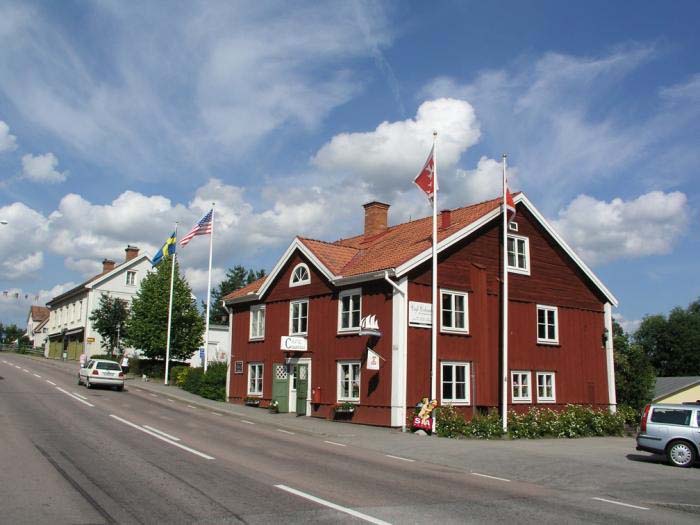
The Peter Cassel Emigrant Museum, Kisa, Östergötland
-Dalakarl
............................
From Stromsburg to Strömsborg
The above title was from an article in a magazine published in Stromsburg's sister city, Okelbo, Sweden. Here is what the article said, as best I could translate:
"Recently, three adventurous Americans visited Okelbo to seek their roots with the help of the Genealogical Society. Former Senator and Veteran Jerry Wilhoft and his cousin Ramona Larsson Bock understand that their families emigrated to the West in the 1860’s. Jerry’s radiant wife Shirley, who is herself of German ancestry, came with on this long journey – all three having known each other since childhood. This was their first visit to Sweden.
Stromsburg, Nebraska, was founded by emigrants from Okelbo in the 1860’s. The name is taken from Strömsborg here in Okelbo and since 1966 has held the title 'Swede Capital of Nebraska.' A yearly summer festival is held to honor their Swedish roots and a decorative brick wall bears the message, 'Välkommen.'
-'We grew up in a Swedish environment and had our own home version of the language,' said Ramona.
-'Mother was five when coming to the U.S.; I can say six words of Swedish and that not very well,' laughed Jerry, modestly.
They described an upbringing which reflected much of their Swedish heritage, including planting birch trees in their grove and painting farm buildings red. While believing that poverty drove many Swedes to emigrate, Ramona cannot ever remember hearing a negative word from her ancestors about Sweden.
Ramona and Jerry grew up as kin in the same home. All three attended the same high school. Jerry’s first date with Shirley was to the school dance. When he came to her place to pick her up, Shirley’s father was seated right by the door. Jerry greeted him and was met with a grimace. 'In the end, he approved,' objected Shirley. 'At least he didn’t deter me,' commented Jerry, calmly. They have been married 59 years, and have four sons, and, so far, seven grandchildren and four great-grandchildren.
Stromsburg has a long relationship with the Okelbo Genealogical Society. This caused some surprises during the visit. Among these surprises was Ramona’s unexpected encounter at lunch in Svärdsjö with three gents. The three asked if she would like to visit the 'Larsson house' (Jerry’s grandmother’s home in Säbyggeby). They also visited the site of their Rabinius relatives who once lived in Svartnäs. Before going there, Jerry had given a description he received from his mother: the Genealogical Society had a picture from the 1800’s of that very place…it was amazing how little it had changed!
-'That was a major reason for our coming, I don’t know how Ingvar succeeded in identifying this place from my vague description,' said Jerry. He was referring to the Genealogical Society chairman and enthusiast, Ingvar Eriksson. -'That is the part of the Genealogical Society which I am most enthusiastic about; when you can join names and facts with real people and places…and see people’s reactions…that is fantastic,' said Ingvar. Shirley commented on how impressed she was with the friendliness and helpfulness of the staff. Ramona and Jerry agreed. Genealogical Society members go out of their way for visitors. But this is not only about history, but sightseeing as well. Among other things, we enjoyed a fine seafood dinner at the exotic fish restaurant, Axmarbrygga.
-'We thought we had lots of Swedish food at home, but we ate more healthfully here,' observed Shirley. Everyone was impressed with the variety of fish on the menu. Nebraska is in the central U.S., an area known for tall corn, not fish.
The three spent their entire trip in Okelbo. We wished them well by Pålsgården as they left for the airport. It was both a heartfelt and nostalgic farewell. It had been an intense journey with many strong and lasting impressions for us all.
-Johan Beijer and Mattia Färnstrand; Kuxabladet magazine
Thanks to Gladys Johnson and Wayne Johnson for sharing this article sent by Sylvia and Börje Grönberg from Okelbo.
-Dalakarl
.......................
P.T. Buckley Back in the News!
It is literally true: our own P.T. Buckley appeared in recent Nebraska news as the State Historical Society announced the publication of a new book; "Last Days of Red Cloud Agency...Peter T. Buckley's Photograph Collection 1876-1877" by Thomas R. Buecker. What a story! We sent for it immediately.
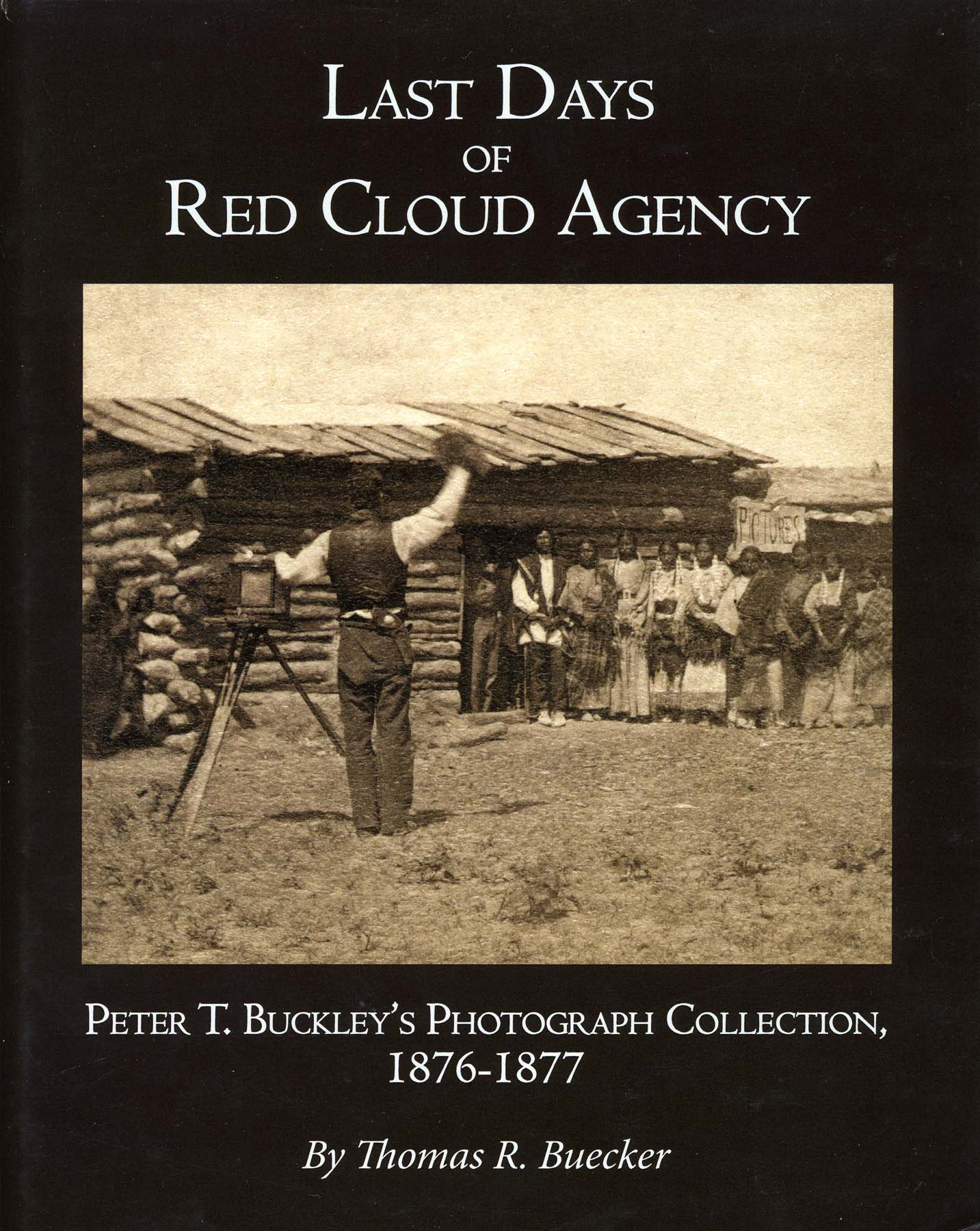
Among the other things learned from this book were the facts that the familiar Fort Robinson was originally the military detachment near the agency, and that after relocating several times the Red Cloud Agency became known as the Pine Ridge agency...another name we know. Thousands of tribesmen and hundreds of soldiers could be found along the White River which flowed northwards toward the Missouri.
While Mr. Buecker's writing is great, it is the pictures which bring the story to life as only pictures can. P.T. Buckley did not take the pictures himself. Enterprising photographers set up primitive studios at these frontier forts in the style of the recent Civil War reporters. Locals flocked to have their pictures taken and curious easterners clamored for these views.
A popular but forgotten mode for these early pictures were the stereo viewers some of us remember. A wood framework with wire supports for double photos printed on cardboard gave surprisingly realistic three-dimensional representations when viewed through the glass lenses.
These were the pictures that Buckley collected. The book uses one side of the double images and so is not in 3-D, but the views are rare and fascinating. It is possible that P.T. himself appears in some of the shots, but the author cannot be certain of this. A totally remarkable book.
-Dalakarl
.......................
More on the Salem Chapel Story
Salem Chapel was a little Swedish Baptist church up near the "bluffs" in Polk county with a big history. It can be seen on the website at Folkets Vän 41, but to recap; the first Baptist church in Stromsburg was replaced with a larger one in 1885 and sold to the Presbyterians. Later it reverted to the Baptists, and around 1905 was dismantled and moved "two miles west and seven north" to become Salem Chapel.
The ground provided was owned by Baptist Par Ulrich Swanson, who memorably was known as "P. U. Swanson," making his name easy to remember?? Now for "the rest of the story." Doris Swanson Johnson, daughter of Rolly and Goldie Swanson has written and assembled a monumental piece of genealogical work on her family. P. U. Swanson stands as the patriarch of this family. This was previously unknown to me.
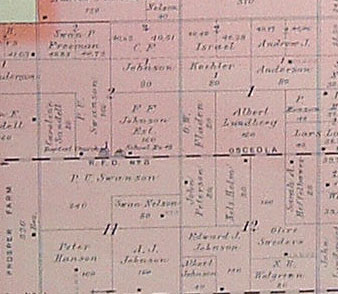
This book is richly illustrated in color. The picture of a farm elevator full of ear corn being unloaded into a red corncrib was the first one I noticed when thumbing through the book. I was immediately transported back to the 1950's and convinced of the artistry of its writer.
Her mother, Goldie Swanson, was a prominent volunteer at Covenant Home in my years there. Her Uncle Paul's house was the first one on our street which I remember touring. The red and white shag carpet of which aunt Myrna was so proud, still survives there in the spacious basement.
A book like this is a chronicle of immigrant industriousness, enduring faith and remarkable achievement on the part of our forebears. It is a treasure.
-Dalakarl
.....................
Some Problems with Swedish Names
This is spelled identically with an English word for an individual human being, a person. So, it began to be pronounced incorrectly according to the original Swedish, which would have sounded like "pear-son." Some did in fact use the spelling Pearson, and some, like our colleague in the Polk County Historical Society, Rich Pehrson, introduced yet another variant.
What we did not see was the use of Pear as a spelling for the first name of someone named Per. Who wants to be called a fruit? And since Per properly pronounced sounds just like pear, most just went over to the Peter option.
I have also been thinking about the name Bohman in the context of its Swedish origin and have had these thoughts:
In Sweden many took "marshal" or military sounding names when joining the military. Examples would be "Swärd" (sword), Hjälm (helmet), Hjältman (hero), etc. One such would be Båghman (bowman, or archer). If this were the name chosen, it might be hard to Anglicize. Why?
A Swede, looking at the word, "Bowman" would want to pronounce it: "Boove-man" because there is no "w" in Swedish and it is always pronounced as "v" and the "o" is always long, as "oo." That would not seem right. And an English speaker, seeing the word "Båghman" might want to say "bagman," which also would be a problem.
In this situation, the spelling "Bohman" might be a good compromise, because the "oh" would approximate the "å" sound. As in Pehrson, the letter "h" came to the rescue. And you can bet, somewhere there had to be at least one Swede named Per Bowman.
-Dalakarl
.........................
What a Wind it Was!
It must have been quite a windstorm as reported in the April 30, 1942 Headlight:
"Victor Anderson had an unfortunate experience in the storm on Monday. He caught hold of a screen door and the force of the wind was so great that he was thrown from the porch, alighting on the ground four or five feet below, striking on his right side. He was taken to the hospital in the ambulance and it was found that he had six ribs fractured. For a time it was thought that his back was injured, but fortunately the injury was of a lesser nature. He was taken to his home on Wednesday and was back at his place of business yesterday."
Which proves you can't keep a good man down, but wait, there's more:
"Bruce Anderson was blown off a haystack in the storm on Monday and fractured both bones in his leg"
and:
"Claire McCormick was struck in the face by a piece of tin blown by the wind on Tuesday afternoon while he was repairing the roof of the building south of the City Hall. He was cut on the nose and temporarily stunned."
It's been a while since we had a big blow like that one!
-Dalakarl
............................
Friends
The group "Friends of the Library" has been stirring, and some things are in the wind which will soon be more widely known, probably before this column reaches print. Anyway, that's a good thing and I am pleased to be part of it.
There is a less structured and smaller group of friends that I like to call "friends of the Arboretum." They like to remain anonymous, but if you should venture out that way you would see remarkable progress they have made this summer.
An even less structured group of friends may be taking shape. They would be the "friends of the immigrant archives" and they have been coming forward with some remarkable things this summer as well. Lately, five rolled-up maps emerged from a local attic, printed in the 1800's showing areas of central Sweden. In all likelihood they came across the Atlantic with their original owners more than a century ago.
Another person with amazing resources came forward with a book "Echoes from the Sanctuary" (Ekon från Helgedomen) which has sermons from Nebraska Free Church preachers...with their pictures, some of which I had never seen.
Some supply old letters which help me sharpen my translating skills. "Kon hade kalvet!" You may be able to guess what that meant...the cow had a calf! Farmer news. Also a youth and children's book called "Snå Stjärnan," Snow Stars. I think this is the word for snow flakes. Doesn't "snow stars" sound better than "flakes" when you think of it?
In reaching out to books from other places, we have learned that the Wilson-Castile store was connected with the New Sweden, IA, Castle family, and that the Baptist Salem chapel north of here sat on land donated by Doris Swanson Johnson's ancestor. Their authors have also become honorary "friends of the archives." And the best part of all may be that we can count each of these groups as our very own personal friends.
-Dalakarl
......................
Dalakarl Gå Bort!
Here we have a new story, but what does Gå bort mean? Just a little Swedish lesson today that reminds us so many foreign words have "cognates," or words in our language that sound similar and have similar meanings. "Bort" has an English cognate like that: "forth." Gå sounds just like "go" in English and can mean the same thing, but also can mean "to walk."
So now we know that the title means "Dalakarl go forth." That doesn't sound quite right, and as we have learned from translating letters sent to and from the immigrants of Stromsburg, there are really two stages to translating. First, the literal translation and then rewriting it in the style of English speech. In that stage, we might make it say "Dalakarl takes a trip."
And yes, he did take a trip, all the way to Sweden and other countries around the Baltic. What a wonderful way to gather material for columns! He even had a successful conversation with a Swedish person. Would you like to know how it went? When the waitress brought a beautiful herring plate, of which I even have a picture, I said "Tak" and she answered "var så god." Wasn't that nice?

Stand by for many more anecdotes and adventures. "Dalakarl Gå Bort."
-Dalakarl
......................
Dalakarl Gå Bort!
When we call the kids in the Netherlands we have to bear in mind that they are six hours or so different in time than us. They extend the same courtesy to us. But when we travel by jet to visit them, we bring our internal clocks with us; hence the phenomenon of "jet lag."
"Jet lag" is something like a newborn infant who "has their days and nights mixed up," in other words, baby wakes up in the middle of the night and wants mom and dad to do so too. All parents are very glad when that stage passes. Jet lag can cause an unwelcomed return to the experience of waking up in the middle of the night and not being able to sleep, or of wanting to fall asleep over one's dinner.
Though this malady is well-known and can be expected, something strange occured in our recent trip to Europe. The dreaded jet lag did not seem to materialize. Gradually the reason for this dawned on us. As senior citizens, it is not unusual to wake up in the middle of the night and "have to get up." Nor is it unusual to experience drowsiness following dinner; "grandpa's favorite time of day" which signals to the grandsons that his nap is about to occur.
We were not bothered by "jet lag" because we already had it at home. It was just normal for us. Maybe we could call it "old lag."
-Dalakarl
........................